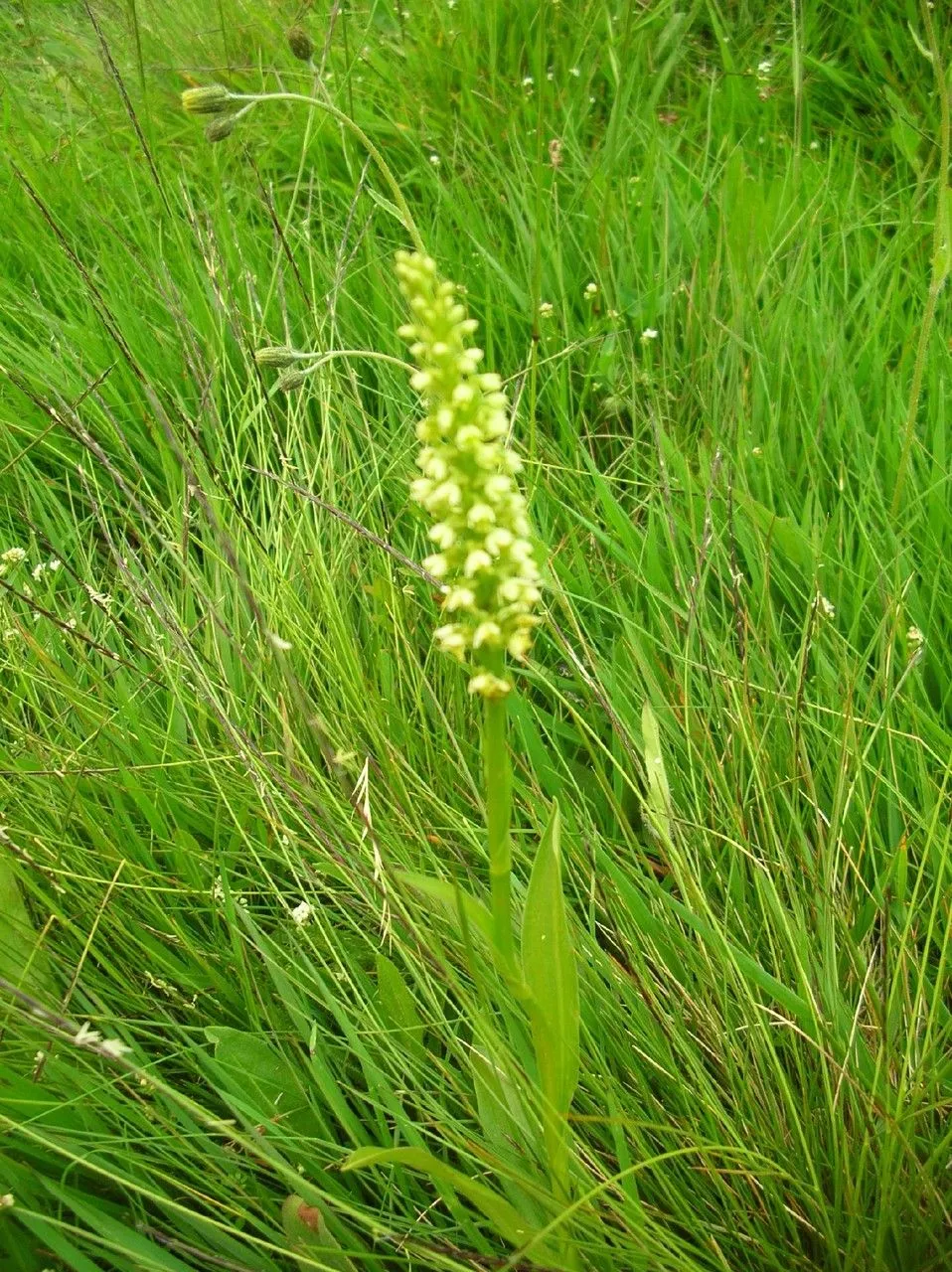
Author: (L.) R.Br.
Bibliography: W.T.Aiton, Hortus Kew. 5: 191 (1813)
Year: 1813
Status: accepted
Rank: species
Genus: Herminium
Vegetable: False
Observations: Temp. Eurasia to Himalaya
The Musk orchid, scientifically known as Herminium monorchis and authored by (L.) R.Br., is a captivating species belonging to the Orchidaceae family. Documented extensively by W.T. Aiton in “Hortus Kew” in 1813, this delicate and intriguing plant has garnered attention from botanists and orchid enthusiasts alike.
Herminium monorchis thrives primarily in temperate regions of Eurasia and extends its presence all the way to the majestic ranges of the Himalayas. Its preferred habitats often include meadows, grasslands, and moist environments where it can enjoy partial sunlight to shaded conditions.
The Musk orchid is celebrated not only for its subtle beauty but also for its distinct fragrance, which becomes particularly noticeable during the flowering period. The flowers are small, with a greenish-yellow hue, arranged in a dense spike that can reach up to 25 centimeters in height. Each flower consists of a delicate three-lobed lip, giving it a unique and intricate appearance.
This orchid blooms typically from June to July, revealing its intricate flowers that attract pollinators, which are essential for its reproduction. Known for its elusive and somewhat rare occurrences in the wild, conservation efforts are key to ensuring its continued survival, given the pressures from habitat loss and environmental changes in its natural regions.
The name “Herminium” is derived from the Greek word “Hermes,” invoking the swift-footed messenger of the gods, possibly alluding to the delicate, intricate steps needed to locate this rare beauty in its natural habitat. “Monorchis” translates from Greek to “one-testicled,” referring to the single tuber found in the root of the plant.
In conclusion, the Musk orchid, Herminium monorchis, stands as a testament to the delicate complexity and beauty of nature. Its presence in both temperate Eurasia and the serene heights of the Himalayas speaks to its adaptability and the unique ecological niches it occupies. As we continue to learn about and from this fascinating orchid, it remains a symbol of the rich biodiversity present in our world’s varied ecosystems.
Deu: einknollige honigorchis, kleine einknolle
Nor: honningblom, desmer-gras, desmer-knapp
Dan: pukkellæbe
Nld: honingorchis
Pol: miodokwiat krzyzowy
Eng: musk orchid
Fra: orchis à un bulbe
Lav: vienguma herminija
Swe: honungsblomster
Cym: tegeirian mwsg, tegeirian mân-flodeuog
Nno: honningblom
Nob: honningblom
Ukr: бровник однобульбовий
Bul: едногрудков херминиум
En: Musk orchid
Bg: Едногрудков херминиум
Da: Pukkellæbe
Nl: Honingorchis, Rechtlip
Fr: Orchis musc, Herminium à un seul tubercule, Orchis à un bulbe, Herminie clandestine, Herminium à un tubercule
De: Einknollige Honigorchis, Kleine Einknolle, Einknolle, Einorchis, Elfenstendel, Honigorchis
It: Orchide ad un bulbo
Lv: Vienguma herminija
No: Honningblom, Desmer-gras, Desmer-knapp
Nb: Honningblom
Nn: Honningblom
Pl: Miodokwiat krzyzowy
Sv: Honungsblomster
Uk: Бровник однобульбовий
Cy: Tegeirian Mwsg, Tegeirian Mân-Flodeuog
Taken Jun 14, 2009 by Tela Botanica − Yoan MARTIN (cc-by-sa)
Taken Aug 15, 2005 by Photoflora – Benoit BOCK (©)
Taken Aug 15, 2005 by Photoflora – Benoit BOCK (©)
Taken Jun 9, 2011 by Tela Botanica − Dominique DUVEAU (cc-by-sa)
Taken Jun 28, 1997 by Tela Botanica − Liliane Roubaudi (cc-by-sa)
Taken Jun 28, 1997 by Tela Botanica − Liliane Roubaudi (cc-by-sa)
Taken Jun 28, 1997 by Tela Botanica − Liliane Roubaudi (cc-by-sa)
Taken Jun 14, 2009 by Tela Botanica − Yoan MARTIN (cc-by-sa)
Taken Jul 24, 2012 by Marcel Ambühl (cc-by-sa)
Taken Feb 10, 2020 by Rohweder Karsten (cc-by-sa)
Taken May 16, 2020 by Paul Chevrier (cc-by-sa)
Taken Apr 16, 2022 by Andrea Merz-Schöpf (cc-by-sa)
Taken May 13, 2022 by Eric klejnot (cc-by-sa)
Taken Jan 1, 1800 by Tela Botanica − Thierry Pernot (cc-by-sa)
Taken Jul 22, 2018 by Georges Mer (cc-by-sa)
Taken Aug 7, 2022 by Thomas Krucker (cc-by-sa)
Taken Aug 7, 2022 by Thomas Krucker (cc-by-sa)
Taken Aug 15, 2005 by Photoflora – Benoit BOCK (©)
Taken Jul 15, 2002 by Photoflora – Benoit BOCK (©)
Taken Jul 15, 2002 by Photoflora – Benoit BOCK (©)
© copyright of the Board of Trustees of the Royal Botanic Gardens, Kew.
© copyright of the Board of Trustees of the Royal Botanic Gardens, Kew.
© copyright of the Board of Trustees of the Royal Botanic Gardens, Kew.
Taken Jul 15, 2002 by Photoflora – Benoit BOCK (©)
Taken Jul 15, 2002 by Photoflora – Benoit BOCK (©)
Taken Jan 1, 1970 by Photoflora – L’Abbé COSTE (©)
Light: 7
Bloom months: [‘may’, ‘jun’, ‘jul’, ‘aug’]
Family: Myrtaceae Author: (F.Muell.) K.D.Hill & L.A.S.Johnson Bibliography: Telopea 6: 402 (1995) Year: 1995 Status:…
Family: Rubiaceae Author: Pierre ex A.Froehner Bibliography: Notizbl. Bot. Gart. Berlin-Dahlem 1: 237 (1897) Year:…
Family: Sapindaceae Author: Koidz. Bibliography: J. Coll. Sci. Imp. Univ. Tokyo 32(1): 38 (1911) Year:…
Family: Asteraceae Author: A.Gray Bibliography: Pacif. Railr. Rep.: 107 (1857) Year: 1857 Status: accepted Rank:…
Family: Fabaceae Author: Medik. Bibliography: Vorles. Churpfälz. Phys.-Ökon. Ges. 2: 398 (1787) Year: 1787 Status:…
Family: Aspleniaceae Author: (Cav.) Alston Bibliography: Bull. Misc. Inform. Kew 1932: 309 (1932) Year: 1932…